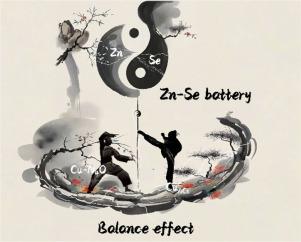调节吸附平衡效应促进锌硒水电池中硒阴极氧化还原反应动力学
IF 20.2
1区 材料科学
Q1 CHEMISTRY, PHYSICAL
引用次数: 0
摘要
锌硒水电池具有固有的安全性和较高的理论容量,具有广阔的应用前景。然而,硒阴极的氧化还原反应动力学缓慢,限制了其发展。设计具有合适吸附能力的功能催化主体材料是促进硒氧化还原反应动力学的关键。我们构建了由轴向氧配位的Cu单原子和相邻的Cu原子团簇(Cu- n40o /CuACs)组成的催化主体材料,探讨其对Se氧化还原反应的适宜吸附能力的调节机制。cu - n40o /CuACs使锌硒水电池在0.2 a g-1时具有643 mAh g-1的比容量和快速的硒氧化还原反应动力学。实验表征和密度泛函理论证实了cu - n40o /CuACs的“吸附平衡效应”。邻近的cuac可以增强对硒的吸附能力。轴向配位的O原子可以促进电子离域和d带中心下移,减弱CuACs带来的过量吸附能力,降低氧化还原反应的能垒。CuACs簇与轴向O原子之间的吸附平衡效应使得cu - n40o /CuACs表现出优异的催化效果。本研究为优化SACs吸附能力与锌硒水电池氧化还原反应动力学之间的催化行为提供了新的见解。本文章由计算机程序翻译,如有差异,请以英文原文为准。


The modulation of adsorption balance effect for promoting selenium cathode redox reaction kinetics in aqueous zinc-selenium battery
Aqueous zinc-selenium (Zn-Se) battery shows promising applications because of its inherent safety and high theoretical capacity. However, the slow redox reaction kinetics of Se cathode limit its development. The strategy of designing functional catalytic host materials with suitable adsorption ability is essential to promote Se redox reaction kinetics. We construct a catalytic host material consisting of axially oxygen-coordinated Cu single atoms and neighboring Cu atomic clusters (Cu-N4O/CuACs) to probe its modulation mechanism of suitable adsorption ability on Se redox reaction. The Cu-N4O/CuACs enable the aqueous Zn-Se battery to exhibit a specific capacity of 643 mAh g–1 at 0.2 A g–1 and fast Se redox reaction kinetics. Experimental characterization and density functional theory confirm the “adsorption balance effect” of Cu-N4O/CuACs. The neighboring CuACs can enhance the adsorption ability for Se species. The axially coordinated O atoms can promote electron delocalization and downshift d-band center, weakening the excess adsorption ability brought by CuACs and lowering the energy barrier of redox reaction. The adsorption balance effect between clusters of CuACs and axial O atom causes Cu-N4O/CuACs to exhibit excellent catalytic effect. This work gives new insights for the optimization of the catalytic behavior between the adsorption ability of SACs and redox reaction kinetics in aqueous Zn-Se battery.
求助全文
通过发布文献求助,成功后即可免费获取论文全文。
去求助
来源期刊

Energy Storage Materials
Materials Science-General Materials Science
CiteScore
33.00
自引率
5.90%
发文量
652
审稿时长
27 days
期刊介绍:
Energy Storage Materials is a global interdisciplinary journal dedicated to sharing scientific and technological advancements in materials and devices for advanced energy storage and related energy conversion, such as in metal-O2 batteries. The journal features comprehensive research articles, including full papers and short communications, as well as authoritative feature articles and reviews by leading experts in the field.
Energy Storage Materials covers a wide range of topics, including the synthesis, fabrication, structure, properties, performance, and technological applications of energy storage materials. Additionally, the journal explores strategies, policies, and developments in the field of energy storage materials and devices for sustainable energy.
Published papers are selected based on their scientific and technological significance, their ability to provide valuable new knowledge, and their relevance to the international research community.
 求助内容:
求助内容: 应助结果提醒方式:
应助结果提醒方式:


